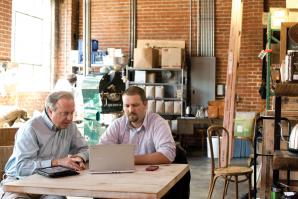For much of Jon Costantino’s career, using public transportation was a daily affair. But moving up in his career, both figuratively and literally, pushed him back behind the wheel.
A longtime Davis resident, he was for years part of the city’s noted bicycle culture, either biking or walking to work. After taking a job in Sacramento with the California Air Resources Board, he became a devotee of commuting by train. It was affordable, reliable and, with so many regular riders, even had a sense of community. Life was good.
But a few years ago, seeking a simpler existence for their kids, Costantino and his wife, Sharon, purchased their dream home in a small, out-of-the-way area between Auburn and Grass Valley. For the first time, they were completely rural.
The move didn’t affect him all that much at first. Although his new digs provided the more remote lifestyle he craved, he was still able to get into work by rail, this time on the Capitol Corridor train he could pick up in Auburn. But another major change soon followed: a new job as a consultant with the Sacramento office of Manatt Phelps & Phillips. That move ultimately made train commuting a thing of the past.
“Coming in from Davis, there is a train pretty much every hour,” he says. “But with the train from Auburn, there is only one train in the morning and one in the evening. That was OK when I was with the state because you know you can always shut it down on time and go home. But things don’t work like that in the private sector.”
Not that he didn’t try. He continued to ride the rails for months into his new job. But with his working world now including a steady diet of client dinners, company events and other obligations beyond the regular work day — not to mention numerous obligations to his kids’ school and extracurricular schedules — he finally waved the white flag.
“If you can’t know exactly when you are leaving, you can’t take that train,” he says.
There was of course a price to pay. He now drives approximately 100 miles a day round trip, more on days he has meetings in locales outside of his downtown Sacramento base.
There also is a healthy dose of irony. While at the Air Resources Board, Costantino headed a working group that was instrumental in implementing Assembly Bill 32, the historic 2006 legislation requiring California to drastically lower its greenhouse gas emissions, in part by getting people out of their cars and onto public transportation.
“It does feel ironic to be driving so much now,” he says. He also knows that some people, especially his old colleagues at CARB, look askance at him, but he smiles and says, ”I like to think all those years of walking, biking and taking the train when I lived in Davis evens the ledger out a bit.”
Still, he is hopeful that his old Capitol Corridor train eventually will add more runs to its Auburn-Sacramento schedule. There is talk of doing so, he says, but nothing is imminent. If that day comes, he says he definitely will take advantage.
“I miss it,” he says. “I loved the train.”
Recommended For You

Streetcar Named Desire
Funding questions loom over downtown streetcar project
For nearly two decades, local city officials have envisioned a streetcar that would transport residents and visitors across downtown Sacramento.

Think Anywhere
Is telecommuting the the wave of workforce future?
Pilot and Arba see those offices and the traditional 8-hour workday as inefficient and outdated relics of the industrial age, when a set shift and common location were vital for communicating and performing work.


